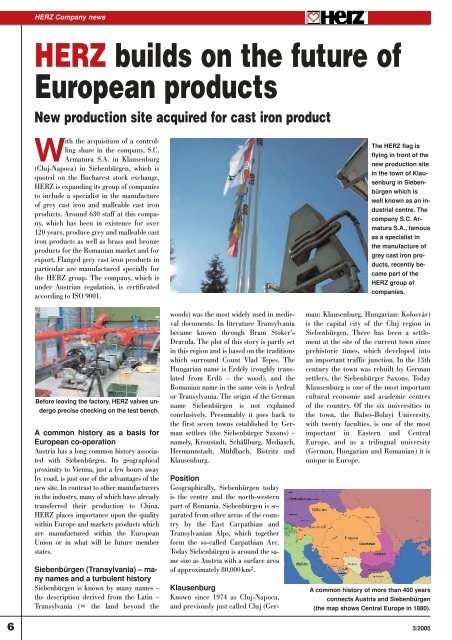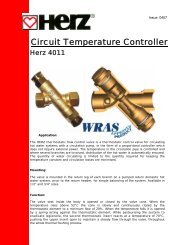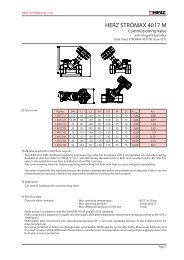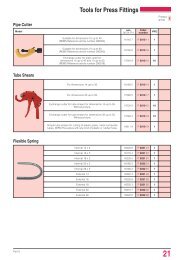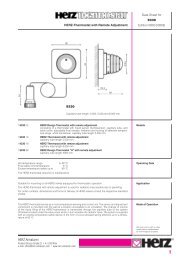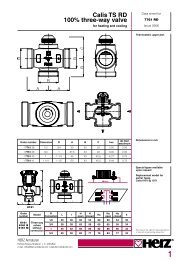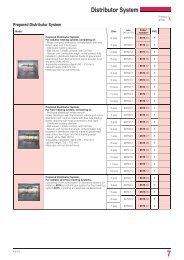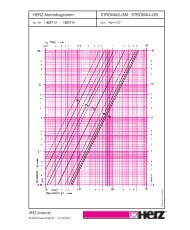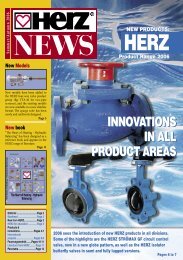Herz Valves UK
Herz Valves UK
Herz Valves UK
You also want an ePaper? Increase the reach of your titles
YUMPU automatically turns print PDFs into web optimized ePapers that Google loves.
HERZ Company newsHERZ builds on the future ofEuropean productsNew production site acquired for cast iron productWith the acquisition of a controllingshare in the company, S.C.Armatura S.A. in Klausenburg(Cluj-Napoca) in Siebenbürgen, which isquoted on the Bucharest stock exchange,HERZ is expanding its group of companiesto include a specialist in the manufactureof grey cast iron and malleable cast ironproducts. Around 630 staff at this company,which has been in existence for over120 years, produce grey and malleable castiron products as well as brass and bronzeproducts for the Romanian market and forexport. Flanged grey cast iron products inparticular are manufactured specially forthe HERZ group. The company, which isunder Austrian regulation, is certificatedaccording to ISO 9001.Before leaving the factory, HERZ valves undergoprecise checking on the test bench.A common history as a basis forEuropean co-operationAustria has a long common history associatedwith Siebenbürgen. Its geographicalproximity to Vienna, just a few hours awayby road, is just one of the advantages of thenew site. In contrast to other manufacturersin the industry, many of which have alreadytransferred their production to China,HERZ places importance upon the qualitywithin Europe and markets products whichare manufactured within the EuropeanUnion or in what will be future memberstates.Siebenbürgen (Transylvania) – manynames and a turbulent historySiebenbürgen is known by many names –the description derived from the Latin –Transylvania (= the land beyond thewoods) was the most widely used in medievaldocuments. In literature Transylvaniabecame known through Bram Stoker’sDracula. The plot of this story is partly setin this region and is based on the traditionswhich surround Count Vlad Tepes. TheHungarian name is Erdély (roughly translatedfrom Erdö – the wood), and theRomanian name in the same vein is Ardealor Transylvania. The origin of the Germanname Siebenbürgen is not explainedconclusively. Presumably it goes back tothe first seven towns established by Germansettlers (the Siebenbürger Saxons) –namely, Kronstadt, Schäßburg, Mediasch,Hermannstadt, Mühlbach, Bistritz andKlausenburg.PositionGeographically, Siebenbürgen todayis the centre and the north-westernpart of Romania. Siebenbürgen is separatedfrom other areas of the countryby the East Carpathian andTransylvanian Alps, which togetherform the so-called Carpathian Arc.Today Siebenbürgen is around the samesize as Austria with a surface areaof approximately 80,000 km 2 .KlausenburgKnown since 1974 as Cluj-Napoca,and previously just called Cluj (Ger-The HERZ flag isflying in front of thenew production sitein the town of Klausenburgin Siebenbürgenwhich iswell known as an industrialcentre. Thecompany S.C. ArmaturaS.A., famousas a specialist inthe manufacture ofgrey cast iron products,recently becamepart of theHERZ group ofcompanies.man: Klausenburg, Hungarian: Kolosvár)is the capital city of the Cluj region inSiebenbürgen. There has been a settlementat the site of the current town sinceprehistoric times, which developed intoan important traffic junction. In the 13thcentury the town was rebuilt by Germansettlers, the Siebenbürger Saxons. TodayKlausenburg is one of the most importantcultural economic and academic centresof the country. Of the six universities inthe town, the Babes-Bolayi University,with twenty faculties, is one of the mostimportant in Eastern and CentralEurope, and as a trilingual university(German, Hungarian and Romanian) it isunique in Europe.A common history of more than 400 yearsconnects Austria and Siebenbürgen(the map shows Central Europe in 1880).6 3/2005


